|
BALLAST
& TRIM
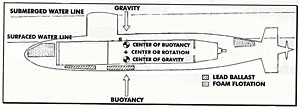 |
1.
To ensure proper R/C performance, your boat will
need ballast weights and flotation foam. Your WTC's
3" ballast tank provides ample volume to float
your Permit. Lead weight must be added to the
bottom of the hull, underneath the tank, to both keep
the boat upright on the surface and properly offset
the buoyancy in the WTC dry spaces when the ballast
tank is flooded. In addition, closed cell flotation
foam should be added below the surfaced waterline to
establish the boat's level trim when submerged. (image
courtesy D&E Miniatures)
|
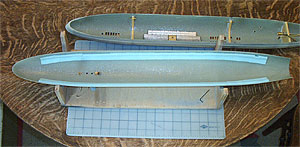 |
2.
Cut two strips of 3/16" closed cell foam 1"
wide and 25" long. With an X-acto knife, slice
half way through the foam down each strip's length (this
enables it to match the hull contour more easily). Using
waterproof silicone adhesive, glue the strips to the
inside of the upper hull, port and starboard, just below
the surfaced waterline (start at the bow sonar dome
demarcation line and work aft). Once the adhesive dries,
place the upper hull on the lower hull and check the
fit. Trim or sand down any high spots on the foam that
prevent the proper mating of the two hull pieces.
|
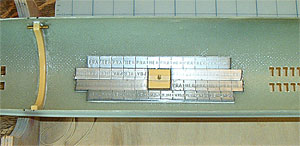 |
3.
Affix 12 oz of lead to the inside of the hull on the
bottom beneath the ballast tank. Self-adhesive 3oz bars
can be found in most hobby stores, or silicone adhesive
can be used. Button up the boat with everything needed
for a patrol including WTC, linkages, running gear and
battery.
|
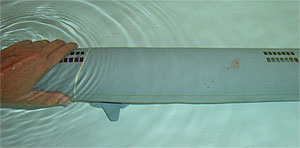 |
4.
Fill your bathtub. Place rubber bands around the hull
near the bow, stern and ballast tank area. Put the boat
in the water and turn it over to fill the ballast tank.
Gently rock the hull to ensure all trapped air bubbles
are released. Turn the boat back over, keeping it submerged.
|
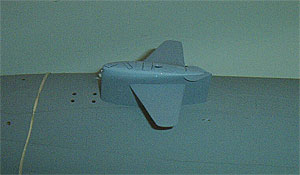 |
5. Proper
submerged waterline is 1/4" of sail showing
with the boat in level trim. This provides slightly
positive buoyancy for patrols. If the boat rides
too high, slip weights under the rubber bands at
the ballast tank area until the proper waterline
is achieved. The boat depicted is close to the proper
height with 12 ounces of lead.
NOTE:
If your boat is too heavy, add foam to bring it up
rather than removing weight. For stable, upright
running, 10-12 ozs. are needed to counteract the
torque from the prop. |
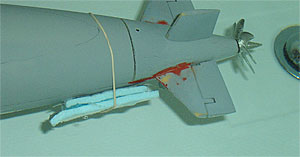 |
6. With the boat at the proper submerged waterline,
level trim must be obtained. Here the boat is down by
the stern. Place small pieces of foam under the rubber
bands aft below the surfaced waterline until the boat
is level. |
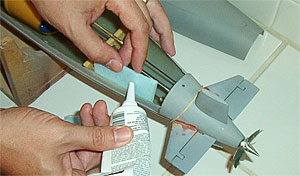 |
7.
Remove the boat from the water. Note where the foam
and lead was placed on the hull under the rubber bands.
Remove the pieces and set them aside. Dry the hull interior.
Use silicone adhesive and affix the foam and lead pieces
to the inside of the hull in their respective locations
(make sure the foam is below the surfaced waterline, yet
high in the hull if possible)). |
 |
8.
Once the adhesive cures, return to the bathtub and flood
your boat until all air is out of the ballast tank and
hull. Leave the boat in the water for several minutes
more then return and check your work (this allows water
to fill every nook and cranny). The trim may still require
some fine tuning. Add weight and/or foam until it rides
correctly (level with 1/4" of sail above water).
Repeat steps 7-8 until proper trim is achieved. Be patient
and take your time. |
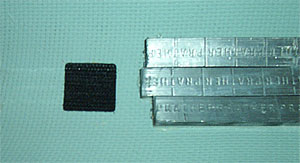 |
9.
NOTE: Different water bodies have different densities
which will require fine tuning the trim each time you
run. A simple trick to facilitate this adjustment is to
Velcro the last bit of weight added to the boat so it
can be removed or increased depending on the particular
need at the pond. |
| |
Detail
& Paint
|
|
|
Which
Kind of Foam?
Most
of us have an old styrofoam pool float laying around
somewhere. Unfortunately, the large cell styrofoam it
contains is unsuitable for r/c submarine use. Closed
cell foam insulation used in home construction, such
as Dow BlueCor, works well and comes in thicknesses
as small as 1/4".
What
About Surfaced Trim?
The
upper hull of the Permit has a scribed line depicting
the scale surfaced waterline. However, trimming your
boat to ride exactly at this line is secondary to establishing
the correct submerged trim. Establishing the proper
submerged trim is essential for safe underwater operations
and will usually result in a surfaced trim close to
the scale waterline. However, unless a Permit
boat is at rest, it is virtually impossible to determine
if a model is riding at it's scale surfaced waterline
due to the minimal freeboard these SSNs possessed. Once
underway, waves will wash over the hull and even if
the surfaced waterline is off, the model will look quite
realistic.
|
|



